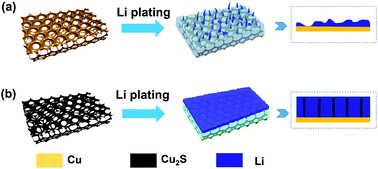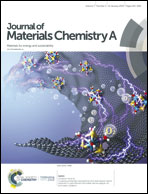Realizing stable lithium deposition by in situ grown Cu2S nanowires inside commercial Cu foam for lithium metal anodes†
Abstract
Lithium metal is the most promising anode for next-generation rechargeable lithium batteries but Li dendrite growth and the resulting safety issues resulting from the non-uniform Li deposition hinder its practical use. Considering the high cost and complication of the currently reported approaches to suppress the Li dendrite growth, in this study we have modified a low-cost commercial three-dimensional (3D) Cu foam into a high-performance host for stable Li deposition by the growth of Cu2S nanowires (NWs) inside the Cu framework. The Cu2S NWs were grown by a simple and scalable chemical approach, and they reduce the local current density and homogenize the Li ion distribution because of the increased contact area of the 3D Cu2S NWs/Cu with the electrolyte. They also enable the formation of a protective solid electrolyte interphase (SEI) film containing Li2S2/Li2S. The prepared 3D Cu2S NWs/Cu current collector enables dendrite-free Li deposition/stripping and gives a stable cycling performance with a high coulombic efficiency (95.5% for more than 150 cycles at 2 mA cm−2). Full cells with LiFePO4 as the cathode also exhibit improved cycling stability and improved coulombic efficiency, showing the potential of this host in the use of stable Li metal anodes.

- This article is part of the themed collection: 2019 Journal of Materials Chemistry A HOT Papers


 Please wait while we load your content...
Please wait while we load your content...